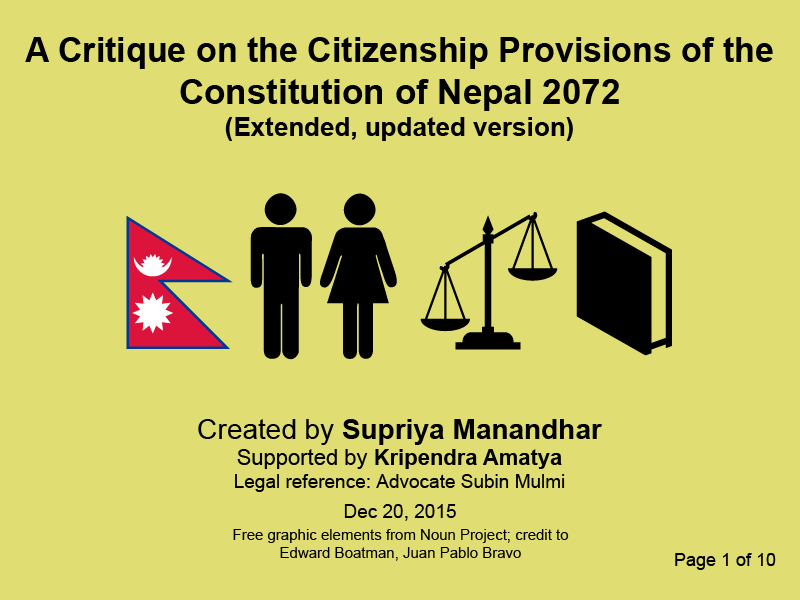 There is no two questions about Nepal being a highly patriarchal society.
There is no two questions about Nepal being a highly patriarchal society.
Economic and gender equality being one of the three main passions of mine — education and social justice being the other two — I have written many blog posts about how Nepal, not unlike many other countries I have lived in and visited, has been and continues to be a country by men, for men, at the expenses of not just the girls and women, but also at the country’s and the men’s! I have also spoken about it at a number of different venues.
Apart from poverty and our culture and tradition making life very very difficult for girls and women, driving an unhealthy number of them to choose death over life, the constitution promulgated last year on September 20, blatantly discriminates against women on the rights to pass on citizenship to children.
Reproduced below are a series of informative and very well made English version of the info-graphs produced by Supriya Manandhar and her friends, about the provision, which originally appeared on Imgur and Facebook. I am reproducing them here with permission from Supriya.
The following Al Jazeera video made by my friend Subina features a Constituent Assembly member who justifies the discriminatory provision by saying:
“Citizenship system in principal and practice is not the same in every country. It depends on the circumstances, legal provision and geopoliticis of different countries. So there should be no question at all how the Nepali people and Nepali state adopts the legal provision. There is no universal principle applicable to all countries.”
Sharing the video on Facebook, to clarify what he meant, I had commented:
‘What he means by “Nepali people” above is Nepali men, mostly hill so-called high caste Hindu men, [roughly 10% of the population, if at that] NOT exactly Nepali people.’
Education, more than anything, has the potential to change this and that’s why I do what I do. Education will bring awareness, and then changes in attitudes and mentality and subsequently, changes in behavior. Sure, it will take a long time, most likely longer than a lifetime, but there is no short-cut!
* * * * * * * *
NB: The post was updated on Monday, Jan. 18, 2016 by moving the Nepali version here.
References
The 2072 Constitution of Nepal, the Nepalese version.
The 2072 Constitution of Nepal, the English version, translated by Nepal Law Society.
References added after the publication of the blog post.
Setopati (Aug. 9, 2018). नागरिकता संशोधन विधेयक- पुरुष पहिलो दर्जाका, महिला दोस्रो (Ammendment to the Constitution: Male First Class, Female Second Class [Citizen]). [Added on Aug. 9, 2018.]
Nepali Times (Aug. 17, 2018). Stateswomanship. [Added on Aug. 21, 2018.]
Nepali Times (Aug. 17, 2018). Nepal’s suffragette moment. [Added on Aug. 21. 2018.]
Nepali Times (Feb. 3-9, 2012). In the name of the father. [Added on Aug. 21 2018.]
Nepali Times (Dec. 21-29, 2012). Patriarchy in the political hierarchy. [Added on Aug. 21, 2018.]
Nepali Times (Oct. 16-22, 2015). The right to have rights. [Added on Aug. 21, 2018.]
Chaukath in a twitter thread has published excellent descriptive charts summarizing the major issues with the highly discriminatory citizenship provision in the constitution including the recent amendment. [Added on July 19, 2020.]
Nepali Times (Dec. 19, 2020). Nepal’s unequal Citizenship Law. [Added Dec. 21, 2020.]

What it describes about breast feeding time for working woman?
Sorry to say but, in the context of the blog post, I have absolutely no idea what you are talking/asking about!